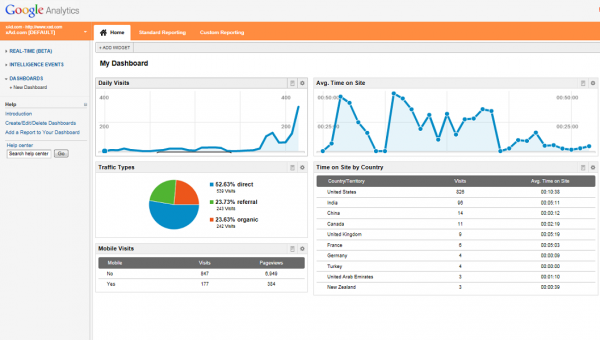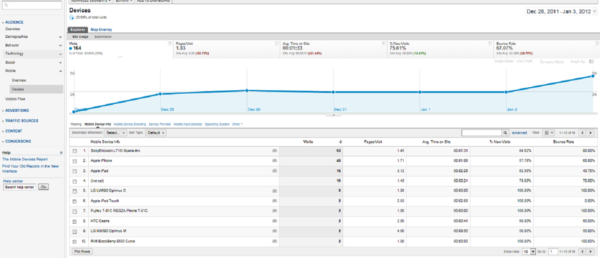Get Your Site Mobile-Ready With Web Analytics
This year, mobile will come into its own as a mainstream marketing medium, as more businesses allocate larger budgets to mobile advertising and, especially, to developing mobile websites. And that’s a good thing, considering usage of the mobile Web is exploding. In fact, a Google report shows that the percentage of search queries stemming from […]
This year, mobile will come into its own as a mainstream marketing medium, as more businesses allocate larger budgets to mobile advertising and, especially, to developing mobile websites. And that’s a good thing, considering usage of the mobile Web is exploding.
In fact, a Google report shows that the percentage of search queries stemming from mobile continues to grow for many industries:
- Restaurants: 29.6%
- Auto: 16.8%
- Electronics: 15.5%
- Finance/Insurance: 15.4%
- Beauty/Personal: 14.9%
And those numbers are just the tip of the iceberg. If you’re wondering whether the trend holds true for your industry, your own analytics can help you solve the mystery of how mobile consumers are engaging and interacting with your website.
See What Consumers See
The first rule of thumb is: Never assume your traditional site renders well for smart screens. Tools like Mobile Moxie reveal how your site appears via smartphones, so you can determine if it’s in need of a mobile facelift. Before making any changes, cross-check your traditional site’s analytics to learn about your mobile visitors. In doing so, you’ll be able to better target your design, content and optimization efforts for specific mobile experiences.
For this article, I will use Google Analytics to walk through how to access and apply the mobile-specific traffic data for your site.
How To Access Essential Analytics Data — And What To Do With It
When you first log in to Google Analytics, you’ll see a dashboard similar to what’s below.
To get in-depth mobile-traffic data, simply click on “Standard Reporting” in the orange navigation at the top, followed by “Audience” and then “Mobile” (see below). To get reporting for a specific time period — which is important if you want to track specific campaigns — you can segment your data by setting a custom date in the top right.
From the “Overview” pane, you can extract information that is crucial to understanding your mobile visitors. For example, click any of the areas located directly above the blue line graph to learn more about:
- Visits/New Visits: If you notice that your overall traffic has a high percentage of mobile visits, you’ll be able to justify developing a mobile-friendly site much more quickly. For the date range pulled (see the example below), you can see that over 20 percent of site visits were from mobile —- a clear indication that a mobile site is needed. With higher mobile traffic, your site should satisfy the basic needs of smartphone users.For example, nearly 40 percent of mobile searches are local, with 61 percent of consumers following up with phone calls and 58 percent with in-store visits.
With that in mind, design with the mobile lifestyle in mind, including putting your basic business and contact information up front as well as providing click-to-call and mapping/navigation. It’s also noteworthy to watch new visits increase as smartphone penetration and your mobile efforts improve.
- Pages per Visit: How deep are mobile users navigating within your site? Due to small screen sizes and sensitive touchscreens — which don’t always take kindly to larger human fingers — mobile users don’t click as much as desktop users.
Again, using the example below, we can see that desktop users visited an average of five pages, whereas mobile visitors only viewed up to two. Based on that, write your product/service descriptions succinctly to eliminate endless scrolling and clicking. If clicking-through is necessary, make sure links, navigation and buttons can be accessed without hassle.
- Bounce Rate/Average Time on Site: Did you know that 80 percent of consumers immediately quit their shopping if they have a bad experience on mobile devices? Average time and bounce rate can be indicators that your site isn’t performing well on mobile devices or living up to mobile consumers’ expectations, from both a content and functionality standpoint.
In the example below, mobile visitors spent a little more than one minute on the site versus desktop users, who spent over four minutes.Although this clearly shows that mobile users are spending less time on the site, it doesn’t necessarily indicate a problem because mobile users typically have an immediate need and are looking for specific information. As we’ll explore a little later, you can actually view the top pages mobile users visit; such analytics serve as further proof of any issues with your site as well as what content is most important to specific users.
The bottom area of the “Overview” pane gives you advanced options to understand your mobile visitors even better.
Selecting “Technology” reveals traffic per browser, browser version, operating system and the like. Obviously, this data set gives you a clear indication of the types of mobile experiences for which you must design and develop. And it makes testing much easier, since you now know the platforms being used for site access.
Shown next, “Traffic Sources” further segments the reporting by (among others):
- Source: See where your traffic originates, possibly opening up opportunities in link building (SEO), affiliate marketing and reputation management. Here is where you should see your other efforts, particularly your directory and organic business listings, pay off.
- Landing Page: Track how visitors interact with your site, especially the type of content they’re apt to view (e.g., a blog, contact info, a coupon page, etc.). Once you have this information, you can better organize, design and optimize for mobile viewing the pages that users are navigating toward.
- Keywords: Understand mobile-search queries (and how they differ from desktop searches), so you can optimize your content and metadata for mobile search engines. Pay special attention to the number of search queries with local intent, as well as brand and category-driven keywords.
Another key piece of data is found by clicking “Devices,” which is located under “Mobile” in the right-hand navigation. There, you can see the top mobile devices that consumers are using to visit your site. Again, what you discover will enable you to specifically target your mobile content, as well as test how your mobile site renders and performs on the most-used devices.
Conclusion
As mobile matures, it’ll make a serious push toward Web-traffic supremacy; in fact, Morgan Stanley reported that mobile-Internet usage will surpass its desktop counterpart by 2014. But, surprisingly, a majority of businesses lack mobile-optimized websites. If your response is, “My traditional website should do the trick,” then you’re sadly mistaken.
As Google’s Eric Schmidt reported last year, 60 percent of pre-purchase consumers search for businesses from their mobile devices, while comScore disclosed that two-thirds of mobile-Internet traffic stems from smartphones. Obviously, consumers are increasingly touching their screens to get in touch with local businesses, so it’s time you understood the impact of their behaviors on your website (and, ultimately, your sales).
Contributing authors are invited to create content for MarTech and are chosen for their expertise and contribution to the search community. Our contributors work under the oversight of the editorial staff and contributions are checked for quality and relevance to our readers. MarTech is owned by Semrush. Contributor was not asked to make any direct or indirect mentions of Semrush. The opinions they express are their own.
Related stories





